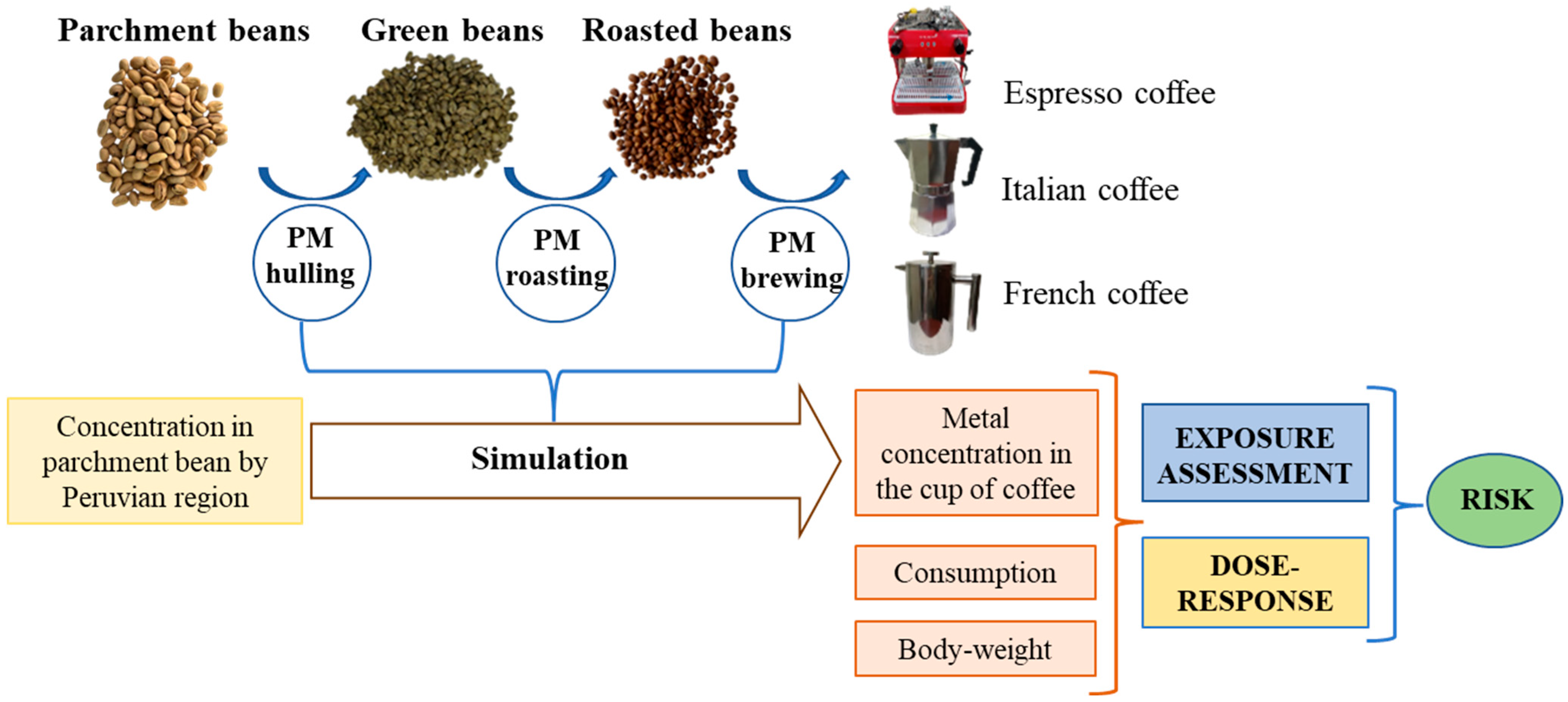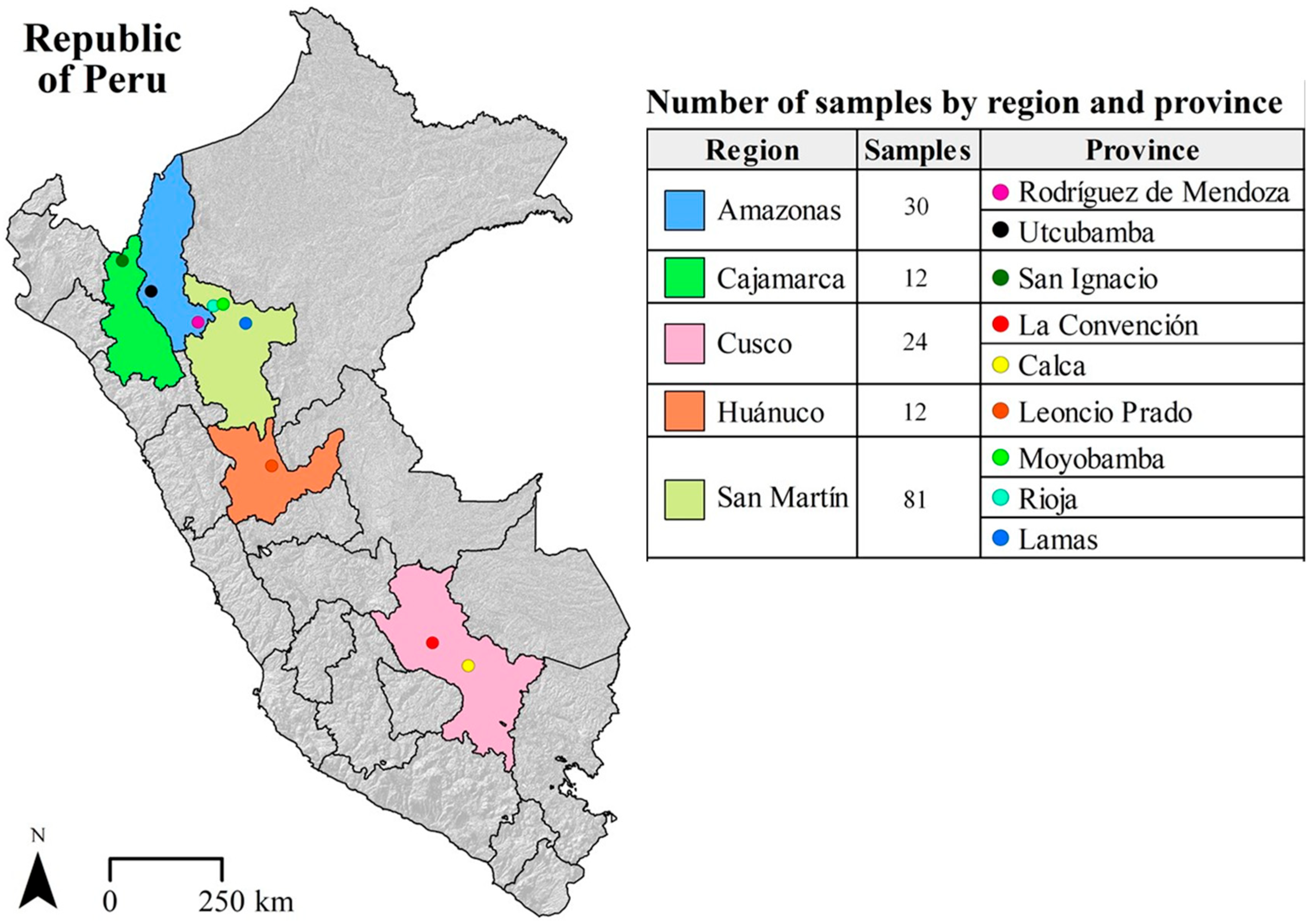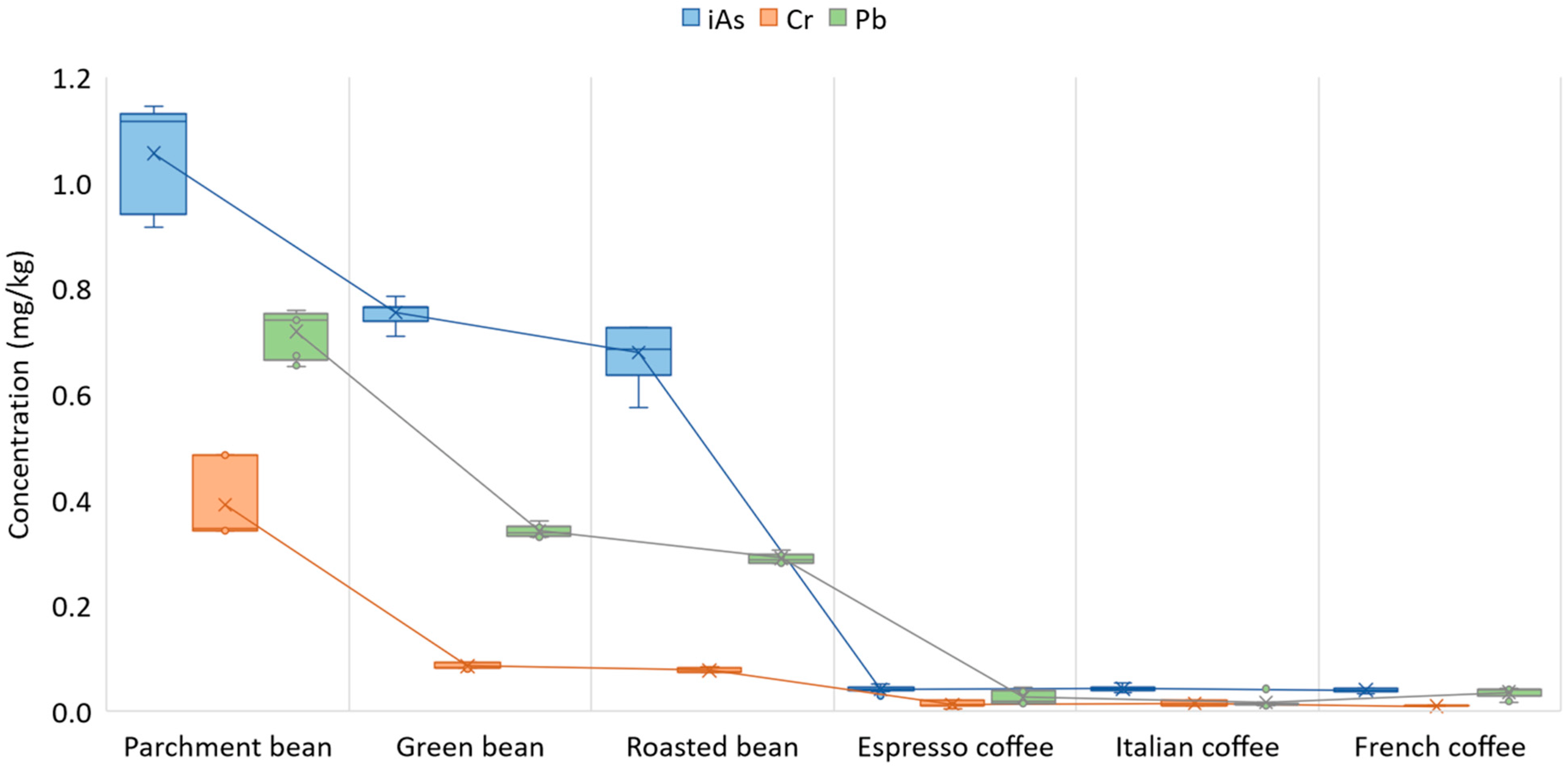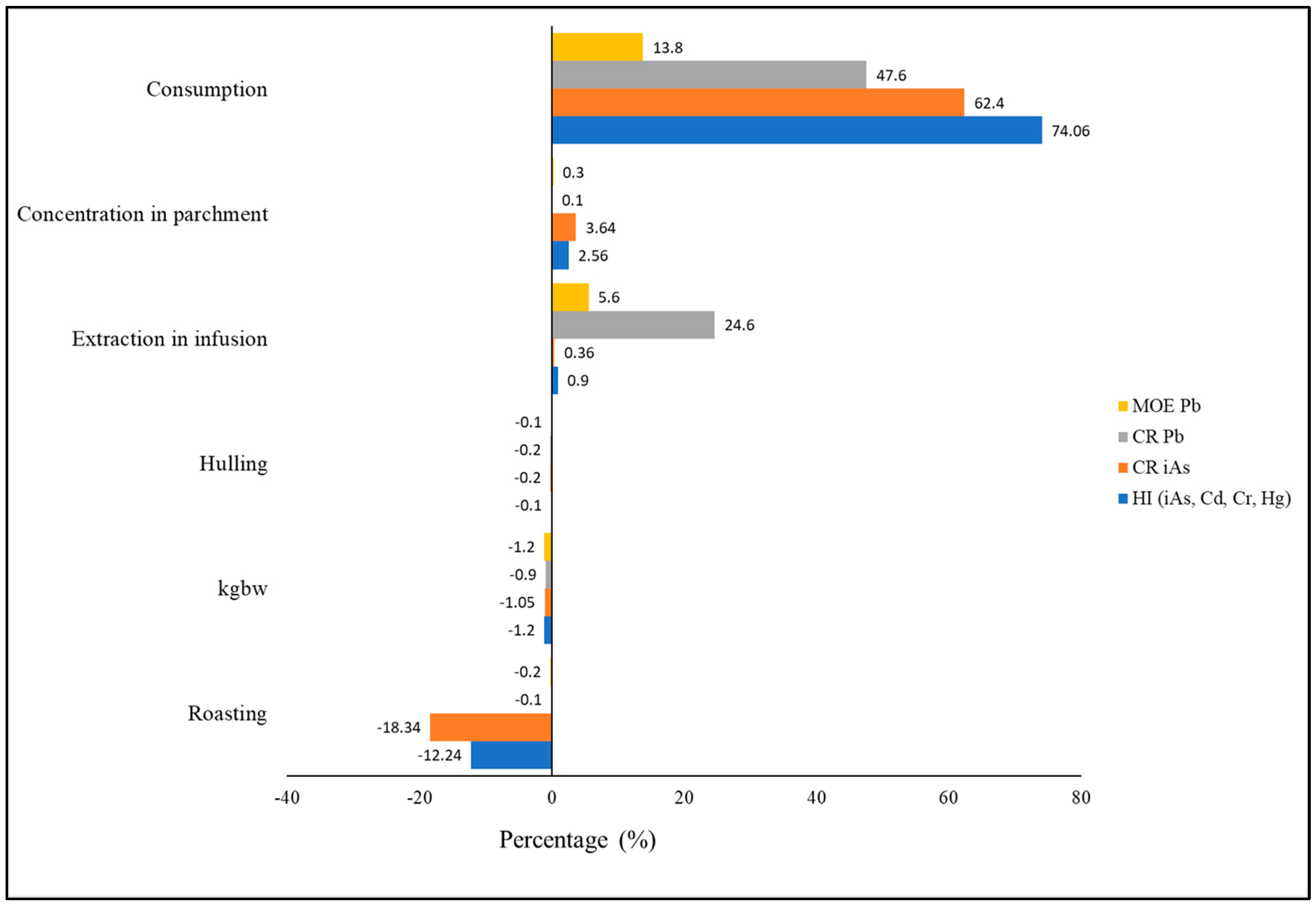Probabilistic Risk Characterization of Heavy Metals in Peruvian Coffee: Implications of Variety, Region and Processing
Abstract
:1. Introduction
2. Materials and Methods
2.1. Sample Collection
2.2. Chemical Analysis
2.3. Risk Assessment
2.4. Statistical Analysis
3. Results and Discussion
3.1. Predictive Modeling
3.2. Metal Concentrations in Parchment Coffee Beans
3.3. Risk Assessment
4. Conclusions
Author Contributions
Funding
Data Availability Statement
Acknowledgments
Conflicts of Interest
References
- International Coffee Organization (ICO). Word Coffee Consumption; International Coffee Organization: London, UK, 2021. [Google Scholar]
- Al-Abdulkader, A.M.; Al-Namazi, A.A.; AlTurki, T.A.; Al-Khuraish, M.M.; Al-Dakhil, A.I. Optimizing Coffee Cultivation and Its Impact on Economic Growth and Export Earnings of the Producing Countries: The Case of Saudi Arabia. Saudi J. Biol. Sci. 2018, 25, 776–782. [Google Scholar] [CrossRef] [PubMed]
- Grembecka, M.; Malinowska, E.; Szefer, P. Differentiation of Market Coffee and Its Infusions in View of Their Mineral Composition. Sci. Total Environ. 2007, 383, 59–69. [Google Scholar] [CrossRef] [PubMed]
- Chavez, S.G.; Mendoza, M.M.; Caetano, A.C. Antioxidants, Phenols, Caffeine Content and Volatile Compounds in Coffee Beverages Obtained by Different Methods. Food Sci. Technol. 2022, 42, e47022. [Google Scholar] [CrossRef]
- Ministerio de Desarrollo Agrario y Riego. Situación Actual Del Café En El País; Ministerio de Desarrollo Agrario y Riego: Lima, Perú, 2021; p. 80.
- Şemen, S.; Mercan, S.; Yayla, M.; Açıkkol, M. Elemental Composition of Green Coffee and Its Contribution to Dietary Intake. Food Chem. 2017, 215, 92–100. [Google Scholar] [CrossRef] [PubMed]
- Ministerio de Desarrollo Agrario y Riego. Cafes Especiales de Perú; Ministerio de Desarrollo Agrario y Riego: Lima, Perú, 2022; p. 53.
- Borjas-Ventura, R.; Alvarado-Huaman, L.; Castro-Cepero, V.; Rebaza-Fernández, D.; Gómez-Pando, L.; Julca-Otiniano, A. Behavior of Ten Coffee Cultivars against Hemileia vastatrix in San Ramón (Chanchamayo, Peru). Agronomy 2020, 10, 1867. [Google Scholar] [CrossRef]
- U.S. Department of Agriculture (USDA). FoodData Central. Available online: https://fdc.nal.usda.gov/fdc-app.html#/food-details/1104137/nutrients (accessed on 20 April 2022).
- Wei, F.; Tanokura, M. Chemical Changes in the Components of Coffee Beans during Roasting; Elsevier Inc.: Amsterdam, The Netherlands, 2015; ISBN 9780124167162. [Google Scholar]
- Yilmaz, P.K.; Hacibekiroğlu, I.; Kolak, U. Effect of Roasting on Antioxidant and Anticholinesterase Capacities of Coffee. J. Food Nutr. Res. 2014, 53, 232–239. [Google Scholar]
- Kotyczka, C.; Boettler, U.; Lang, R.; Stiebitz, H.; Bytof, G.; Lantz, I.; Hofmann, T.; Marko, D.; Somoza, V. Dark Roast Coffee Is More Effective than Light Roast Coffee in Reducing Body Weight, and in Restoring Red Blood Cell Vitamin E and Glutathione Concentrations in Healthy Volunteers. Mol. Nutr. Food Res. 2014, 55, 1582–1586. [Google Scholar] [CrossRef]
- Messina, G.; Zannella, C.; Monda, V.; Dato, A.; Liccardo, D.; De Blasio, S.; Valenzano, A.; Moscatelli, F.; Messina, A.; Cibelli, G.; et al. The Beneficial Effects of Coffee in Human Nutrition. Biol. Med. 2015, 7, 240. [Google Scholar] [CrossRef]
- Ashu, R.; Chandravanshi, B.S. Concentration Levels of Metals in Commercially Available Ethiopian Roasted Coffee Powders and Their Infusions. Bull. Chem. Soc. Ethiop. 2011, 25, 11–24. [Google Scholar] [CrossRef]
- Kowalska, G. The Safety Assessment of Toxic Metals in Commonly Used Herbs, Spices, Tea, and Coffee in Poland. Int. J. Environ. Res. Public Health 2021, 18, 5779. [Google Scholar] [CrossRef]
- Pigozzi, M.T.; Passos, F.R.; Mendes, F.Q. Quality of Commercial Coffees: Heavy Metal and Ash Contents. J. Food Qual. 2018, 2018, 5908463. [Google Scholar] [CrossRef]
- Tripathy, V.; Basak, B.B.; Varghese, T.S.; Saha, A. Residues and Contaminants in Medicinal Herbs—A Review. Phytochem. Lett. 2015, 14, 67–78. [Google Scholar] [CrossRef]
- Hseu, Z.Y.; Su, S.W.; Lai, H.Y.; Guo, H.Y.; Chen, T.C.; Chen, Z.S. Remediation Techniques and Heavy Metal Uptake by Different Rice Varieties in Metal-Contaminated Soils of Taiwan: New Aspects for Food Safety Regulation and Sustainable Agriculture. Soil Sci. Plant Nutr. 2010, 56, 31–52. [Google Scholar] [CrossRef]
- Winiarska-Mieczan, A.; Kwiatkowska, K.; Kwiecień, M.; Zaricka, E. Assessment of the Risk of Exposure to Cadmium and Lead as a Result of the Consumption of Coffee Infusions. Biol. Trace Elem. Res. 2021, 199, 2420–2428. [Google Scholar] [CrossRef]
- Fallahzadeh, R.A.; Khosravi, R.; Dehdashti, B.; Ghahramani, E.; Omidi, F.; Adli, A.; Miri, M. Spatial Distribution Variation and Probabilistic Risk Assessment of Exposure to Chromium in Ground Water Supplies; a Case Study in the East of Iran. Food Chem. Toxicol. 2018, 115, 260–266. [Google Scholar] [CrossRef]
- Mansour, S.A.; Belal, M.H.; Abou-Arab, A.A.K.; Gad, M.F. Monitoring of Pesticides and Heavy Metals in Cucumber Fruits Produced from Different Farming Systems. Chemosphere 2009, 75, 601–609. [Google Scholar] [CrossRef]
- Zhou, H.; Guo, X. Soil Heavy Metal Pollution Evaluation around Mine Area with Traditional and Ecological Assessment Methods. J. Geosci. Environ. Prot. 2015, 3, 28–33. [Google Scholar] [CrossRef]
- Esmaeilzadeh, M.; Jaafari, J.; Mohammadi, A.A.; Panahandeh, M.; Javid, A.; Javan, S. Investigation of the Extent of Contamination of Heavy Metals in Agricultural Soil Using Statistical Analyses and Contamination Indices. Hum. Ecol. Risk Assess. 2019, 25, 1125–1136. [Google Scholar] [CrossRef]
- Vasseghian, Y.; Sadeghi Rad, S.; Vilas-Boas, J.A.; Khataee, A. A Global Systematic Review, Meta-Analysis, and Risk Assessment of the Concentration of Vanadium in Drinking Water Resources. Chemosphere 2021, 267, 128904. [Google Scholar] [CrossRef]
- Roychowdhury, T.; Tokunaga, H.; Ando, M. Survey of Arsenic and Other Heavy Metals in Food Composites and Drinking Water and Estimation of Dietary Intake by the Villagers from an Arsenic-Affected Area of West Bengal, India. Sci. Total Environ. 2003, 308, 15–35. [Google Scholar] [CrossRef]
- EFSA. Scientific Opinion on Arsenic in Food. EFSA J. 2009, 7, 1351. [Google Scholar] [CrossRef]
- WHO/IPCS. Guidance Document on Evaluating and Expressing Uncertenty in Hazard Characterization; World Health Organization: Geneva, Switzerland; International Labour Organization: Geneva, Switzerland; United Nations Environment Programme: Nairobi, Kenya, 2014; ISBN 9789241513548. [Google Scholar]
- Doménech, E.; Martorell, S. Assessment of Safety Margins of Exposure to Non-Genotoxic Chemical Substances in Food. Food Control 2017, 79, 1–9. [Google Scholar] [CrossRef]
- Guo, G.; Zhang, D.; Wang, Y. Probabilistic Human Health Risk Assessment of Heavy Metal Intake via Vegetable Consumption around Pb/Zn Smelters in Southwest China. Int. J. Environ. Res. Public Health 2019, 16, 3267. [Google Scholar] [CrossRef] [PubMed]
- Pohl, P.; Welna, M.; Szymczycha-Madeja, A.; Greda, K.; Jamroz, P.; Dzimitrowicz, A. Response Surface Methodology Assisted Development of a Simplified Sample Preparation Procedure for the Multielement (Ba, Ca, Cu, Fe, K, Mg, Mn, Na, Sr and Zn) Analysis of Different Coffee Brews by Means of Inductively Coupled Plasma Optical Emission Spect. Talanta 2022, 241, 123215. [Google Scholar] [CrossRef]
- Doménech, E.; Escriche, I.; Martorell, S. Exposure Assessment Based on a Combination of Event and Fault Tree Analyses and Predictive Modelling. Food Control 2010, 21, 1338–1348. [Google Scholar] [CrossRef]
- Leiva-Tafur, D.; Goñas, M.; Culqui, L.; Santa Cruz, C.; Rascón, J.; Oliva-Cruz, M. Spatiotemporal Distribution of Physicochemical Parameters and Toxic Elements in Lake Pomacochas, Amazonas, Peru. Front. Environ. Sci. 2022, 10, 885591. [Google Scholar] [CrossRef]
- APHA Standard Methods for the Examination of Water and Wastewater. 2017. Available online: https://beta-static.fishersci.com/content/dam/fishersci/en_US/documents/programs/scientific/technical-documents/white-papers/apha-water-testing-standard-methods-introduction-white-paper.pdf, (accessed on 3 April 2022).
- EPA Environmental Protection Agency. 2022. Available online: https://iris.epa.gov/AdvancedSearch/ (accessed on 1 April 2022).
- Quintanilla, P.; Doménech, E.; Escriche, I.; Carmen Beltrán, M.; Pilar Molina, M. Food Safety Margin Assessment of Antibiotics: Pasteurized Goat’s Milk and Fresh Cheese. J. Food Prot. 2019, 82, 1553–1559. [Google Scholar] [CrossRef]
- Evans, R.M.; Scholze, M.; Kortenkamp, A. Examining the Feasibility of Mixture Risk Assessment: A Case Study Using a Tiered Approach with Data of 67 Pesticides from the Joint FAO/WHO Meeting on Pesticide Residues (JMPR). Food Chem. Toxicol. 2015, 84, 260–269. [Google Scholar] [CrossRef]
- Yu, R.; Liu, Q.; Liu, J.; Wang, Q.; Wang, Y. Concentrations of Organophosphorus Pesticides in Fresh Vegetables and Related Human Health Risk Assessment in Changchun, Northeast China. Food Control 2016, 60, 353–360. [Google Scholar] [CrossRef]
- Barlow, S.; Renwick, A.G.; Kleiner, J.; Bridges, J.W.; Busk, L.; Dybing, E.; Edler, L.; Eisenbrand, G.; Fink-Gremmels, J.; Knaap, A.; et al. Risk Assessment of Substances That Are Both Genotoxic and Carcinogenic. Report of an International Conference Organized by EFSA and WHO with Support of ILSI Europe. Food Chem. Toxicol. 2006, 44, 1636–1650. [Google Scholar] [CrossRef]
- Doménech, E.; Martorell, S.; Kombo-Mpindou, G.O.M.; Macián-Cervera, J.; Escuder-Bueno, I. Risk Assessment of Cryptosporidium Intake in Drinking Water Treatment Plant by a Combination of Predictive Models and Event-Tree and Fault-Tree Techniques. Sci. Total Environ. 2022, 838, 156500. [Google Scholar] [CrossRef] [PubMed]
- ECHA. Services to Support the Assessment of Remaining Cancer Risks Related to the Use of Chromium- and Arsenic-Containing Substances in Applications for Authorisation; ECHA: Helsinki, Finland, 2013. [Google Scholar]
- Committee on Toxicity of Chemicals in Food, Consumer Products and the Environment. Statement on Potential Risks from Arsenic in the Diet of Infants Aged 0 to 12 Months and Children Aged 1 to 5 Years. 2016; pp. 1–47. Available online: https://cot.food.gov.uk/sites/default/files/finalstatementonarsenic_0.pdf (accessed on 1 April 2022).
- Kollander, B.; Sundström, B.; Öhrvik, V.; Abramsson, L. Inorganic Arsenic in Rice and Rice Products on the Swedish Market 2015. Part 1: Survey of Inorganic Arsenic. In Arsenic Research and Global Sustainability, Proceedings of the Sixth International Congress on Arsenic in the Environment (As2016), June 19-23, 2016, Stockholm, Sweden; CRC Press: Boca Raton, FL, USA, 2016; pp. 277–278. [Google Scholar] [CrossRef]
- EFSA Panel on Contaminants in the Food Chain (CONTAM). Scientific Opinion on Lead in Food. EFSA J. 2010, 8, 1570. [Google Scholar] [CrossRef]
- Doménech, E.; Martorell, S. Formulation and Application of the Probability of Exceedance Metric for Risk Characterization of Non-Threshold Chemical Hazards in Food. Food Control 2021, 124, 107910. [Google Scholar] [CrossRef]
- Adler, G.; Nędzarek, A.; Tórz, A. Concentrations of Selected Metals (Na, K, Ca, Mg, Fe, Cu, Zn, Al, Ni, Pb, Cd) in Coffee. Koncentracije. Slov. J. Public Health 2019, 58, 187–193. [Google Scholar] [CrossRef] [PubMed]
- Santato, A.; Bertoldi, D.; Perini, M.; Camin, F.; Larcher, R. Using Elemental Profiles and Stable Isotopes to Trace the Origin of Green Coffee Beans on the Global Market. J. Mass Spectrom. 2012, 47, 1132–1140. [Google Scholar] [CrossRef]
- Vezzulli, F.; Fontanella, M.C.; Lambri, M.; Beone, G.M. Specialty and High-Quality Coffee: Discrimination through Elemental Characterization via ICP-OES, ICP-MS, and ICP-MS/MS of Origin, Species, and Variety. J. Sci. Food Agric. 2023, 103, 4303–4316. [Google Scholar] [CrossRef]
- Berego, Y.S.; Sota, S.S.; Ulsido, M.; Beyene, E.M. The Contents of Essential and Toxic Metals in Coffee Beans and Soil in Dale Woreda, Sidama Regional State, Southern Ethiopia. PeerJ 2023, 11, e14789. [Google Scholar] [CrossRef]
- Getachew, T.; Worku, N. Determination of Essentials and Toxic Metals in Raw and Roasted Coffee in Bule Hora Woreda, Borena Zone, Ethiopia. Int. J. Res. 2014, 1, 1386–1411. [Google Scholar]
- Dubale, W.; Hussen, A.; Rao, V.M. Concentrations of selected metals in coffee (Coffea arabica) beans, leaves and supportive soil of gedeo zone, Ethiopia. Asian J. Sci. Technol. 2017, 8, 6526–6533. [Google Scholar]
- Rodrigues, C.; Brunner, M.; Steiman, S.; Bowen, G.J.; Nogueira, J.M.F.; Gautz, L.; Prohaska, T.; Máguas, C. Isotopes as Tracers of the Hawaiian Coffee-Producing Regions. J. Agric. Food Chem. 2011, 59, 10239–10246. [Google Scholar] [CrossRef]
- Várady, M.; Ślusarczyk, S.; Boržíkova, J.; Hanková, K.; Vieriková, M.; Marcinčák, S.; Popelka, P. Heavy-Metal Contents and the Impact of Roasting on Polyphenols, Caffeine, and Acrylamide in Specialty Coffee Beans. Foods 2021, 10, 1310. [Google Scholar] [CrossRef] [PubMed]
- Árvay, J.; Šnirc, M.; Hauptvogl, M.; Bilčíková, J.; Bobková, A.; Demková, L.; Hudáček, M.; Hrstková, M.; Lošák, T.; Král, M.; et al. Concentration of Micro- and Macro-Elements in Green and Roasted Coffee: Influence of Roasting Degree and Risk Assessment for the Consumers. Biol. Trace Elem. Res. 2019, 190, 226–233. [Google Scholar] [CrossRef] [PubMed]
- Albals, D.; Al-Momani, I.F.; Issa, R.; Yehya, A. Multi-Element Determination of Essential and Toxic Metals in Green and Roasted Coffee Beans: A Comparative Study among Different Origins Using ICP-MS. Sci. Prog. 2021, 104, 1–17. [Google Scholar] [CrossRef] [PubMed]
- Nogaim, Q.A.; Al-Dalali, S.; Al-Badany, A.; Farh, M. Determination of Some Heavy Metals in Yemeni Green Coffee. J. Appl. Chem. 2014, 2, 13–18. [Google Scholar]
- Jeszka-Skowron, M.; Stanisz, E.; De Peña, M.P. Relationship between Antioxidant Capacity, Chlorogenic Acids and Elemental Composition of Green Coffee. LWT Food Sci. Technol. 2016, 73, 243–250. [Google Scholar] [CrossRef]
- Massoud, R.; Mirmohammadmakki, F.; Makki, S.F.M.; Mirmohammadmakki, N.; Massoud, A. Evaluation of Heavy Metals in Roasted Coffee Powder in Iran and Turkey. Coffee Sci. 2022, 17, e172013. [Google Scholar] [CrossRef]
- Mohammed, A.A.; Mohamed, H.O.; Muftah, E.K. Heavy Metals Contents in Some Commercially Available Coffee, Tea, and Cocoa Samples in Misurata City—Libya. Prog. Chem. Biochem. Res. 2019, 2, 99–107. [Google Scholar] [CrossRef]
- Tesfay Gebretsadik, A. Levels of Selected Essential and Nonessential Metals in Roasted Coffee Beans of Yirgacheffe and Sidama, Ethiopia. Am. J. Environ. Prot. 2015, 4, 188–192. [Google Scholar] [CrossRef]
- da Silva, S.A.; Mendes, F.Q.; Reis, M.R.; Passos, F.R.; de Carvalho, A.M.X.; de Oliveira Rocha, K.R.; Pinto, F.G. Determination of Heavy Metals in the Roasted and Ground Coffee Beans and Brew. Afr. J. Agric. Res. 2017, 12, 221–228. [Google Scholar] [CrossRef]
- Suseela, B.; Bhalke, S.; Kumar, A.V.; Tripathi, R.M.; Sastry, V.N. Daily Intake of Trace Metals through Coffee Consumption in India. Food Addit. Contam. 2001, 18, 115–120. [Google Scholar] [CrossRef]
- Nedzarek, A.; Tórz, A.; Karakiewicz, B.; Clark, J.S.; Laszczyńska, M.; Kaleta, A.; Adler, G. Concentrations of Heavy Metals (Mn, Co, Ni, Cr, Ag, Pb) in Coffee. Acta Biochim. Pol. 2013, 60, 623–627. [Google Scholar] [CrossRef] [PubMed]
- Janda, K.; Jakubczyk, K.; Baranowska-Bosiacka, I.; Kapczuk, P.; Kochman, J.; Rȩbacz-Maron, E.; Gutowska, I. Mineral Composition and Antioxidant Potential of Coffee Beverages Depending on the Brewing Method. Foods 2020, 9, 121. [Google Scholar] [CrossRef] [PubMed]
- Onianwa, P.C.; Adetola, I.G.; Iwegbue, C.M.A.; Ojo, M.F.; Tella, O.O. Trace Heavy Metals Composition of Some Nigerian Beverages and Food Drinks. Food Chem. 1999, 66, 275–279. [Google Scholar] [CrossRef]
- Turkyilmaz, A.; Sevik, H.; Isinkaralar, K.; Cetin, M. Using Acer Platanoides Annual Rings to Monitor the Amount of Heavy Metals Accumulated in Air. Environ. Monit. Assess. 2018, 19, 578. [Google Scholar] [CrossRef] [PubMed]
- Sevik, H.; Cetin, M.; Ozel, H.B.; Ozel, S.; Zeren Cetin, I. Changes in Heavy Metal Accumulation in Some Edible Landscape Plants Depending on Traffic Density. Environ. Monit. Assess. 2020, 192, 78. [Google Scholar] [CrossRef]
- Khunlert, P.; Tanhan, P.; Poapolathep, A.; Poapolathep, S.; Imsilp, K. Pyrethroid and Metal Residues in Different Coffee Bean Preparing Processes and Their Human Health Risk Assessments via Consumption. bioRxiv 2021. [Google Scholar] [CrossRef]
- Fowler, M.S.; Coutel, F. Cocoa Beans: From Tree to Factory. In Beckett’s Industrial Chocolate Manufacture and Use, 5th ed.; Beckett, S.T., Fowler, M.S., Ziegler, G.R., Eds.; John Wiley & Sons, Inc.: Hoboken, NJ, USA, 2017. [Google Scholar] [CrossRef]
- Arévalo-Gardini, E.; Arévalo-Hernández, C.O.; Baligar, V.C.; He, Z.L. Heavy Metal Accumulation in Leaves and Beans of Cacao (Theobroma Cacao L.) in Major Cacao Growing Regions in Peru. Sci. Total Environ. 2017, 605–606, 792–800. [Google Scholar] [CrossRef]
- Yang, L.; Wen, K.S.; Ruan, X.; Zhao, Y.X.; Wei, F.; Wang, Q. Response of Plant Secondary Metabolites to Environmental Factors. Molecules 2018, 23, 762. [Google Scholar] [CrossRef]
- Taghizadeh, S.F.; Azizi, M.; Hassanpourfard, G.; Rezaee, R.; Karimi, G. Assessment of Carcinogenic and Non-Carcinogenic Risk of Exposure to Metals via Consumption of Coffee, Tea, and Herbal Tea in Iranians. Biol. Trace Elem. Res. 2023, 201, 1520–1537. [Google Scholar] [CrossRef]




| Validation Parameters | Heavy Metals | ||||
|---|---|---|---|---|---|
| iAs | Cd | Cr | Hg | Pb | |
| LOD * (mg/Kg) | 0.005 | 0.005 | 0.005 | 0.005 | 0.005 |
| LOQ ** (mg/Kg) | 0.010 | 0.016 | 0.010 | 0.012 | 0.087 |
| Linearity | 0.9962 | 0.9998 | 0.9994 | 0.9835 | 0.9998 |
| Working range (mg/Kg) | LOQ -4 | LOQ -4 | LOQ -4 | LOQ -5 | LOQ -4 |
| Recovery (%) | 99 | 101 | 98 | 101 | 99 |
| Process Stage | iAs | Cr | Pb | ||||||
|---|---|---|---|---|---|---|---|---|---|
| Mean (SD) | 5th | 95th | Mean (SD) | 5th | 95th | Mean (SD) | 5th | 95th | |
| % Removal in hulling | 27.3 (4.4) | 18.4 | 32.3 | 76.2 (3.2) | 71.1 | 82.9 | 52.6 (2.8) | 48.1 | 57.1 |
| % Removal in roasting | 11.7 | 4.8 | 28.4 | 9.9 (1.5) | 7.5 | 12.4 | 14.7 (3.7) | 8.9 | 20.5 |
| % Extraction in brewing | 5.9 (0.9) | 4.8 | 7.5 | 13.4 (4.1) | 6.8 | 20.1 | 8.2 (6.1) | 4.0 | 19.5 |
| Metals | Region | Variety | ANOVA F-Ratio | |||||||||
|---|---|---|---|---|---|---|---|---|---|---|---|---|
| Amazonas | Cajamarca | Cusco | Huánuco | San Martín | Bourbon | Catimor | Caturra | Pache | Típica | Region | Variety | |
| iAs (mg/kg) | 0.57 ± 0.21 a | 0.50 ± 0.20 a | 0.63 ± 0.19 a | 0.62 ± 0.09 a | 0.94 ± 0.17 b | 0.72 ± 0.24 a | 0.76 ± 0.24 a | 0.76 ± 0.29 a | 0.89 ± 0.17 a | 0.79 ± 0.24 a | 39.425 *** | 0.62 ns |
| Cr (mg/kg) | 0.08 ± 0.05 a | 0.05 ± 0.02 a | 0.12 ± 0.06 b | 0.08 ± 0.04 a | 0.21 ± 0.12 c | 0.11 ± 0.08 a | 0.14 ± 0.07 ab | 0.17 ± 0.13 b | 0.39 ± 0.24 c | 0.12 ± 0.09 a | 15.317 *** | 10.041 *** |
| Pb (mg/kg) | 0.64 ± 0.04 a | 0.64 ± 0.03 a | 0.67 ± 0.03 b | 0.64 ± 0.02 a | 0.72 ± 0.05 c | 0.68 ± 0.05 a | 0.69 ± 0.06 ab | 0.69 ± 0.05 ab | 0.73 ± 0.04 b | 0.67 ± 0.05 a | 29.197 *** | 1.84 ns |
| Metal | Region | EDI | HQ | MOE | CR | |||||||||||
|---|---|---|---|---|---|---|---|---|---|---|---|---|---|---|---|---|
| Mean | 5th | 95th | 5th | 50th | 75th | 95th | 5th | 50th | 75th | 95th | 5th | 50th | 75th | 95th | ||
| iAs | Amazonas | 4.7E-05 | 5.1E-06 | 1.5E-04 | 1.7E-02 | 1.0E-01 | 1.9E-01 | 4.9E-01 | 1.3E+01 | 1.1E+02 | 2.6E+02 | 8.2E+02 | 7.7E-06 | 4.6E-05 | 8.7E-05 | 2.3E-04 |
| Cajamar | 4.4E-05 | 4.6E-06 | 1.4E-04 | 1.5E-02 | 9.4E-02 | 1.8E-01 | 4.5E-01 | 1.4E+01 | 1.3E+02 | 2.7E+02 | 9.1E+02 | 6.8E-06 | 4.2E-05 | 8.2E-05 | 2.1E-04 | |
| Cusco | 5.3E-05 | 6.6E-06 | 1.6E-04 | 2.1E-02 | 1.2E-01 | 2.2E-01 | 5.5E-01 | 1.1E+01 | 1.0E+02 | 2.2E+02 | 6.6E+02 | 9.9E-06 | 5.2E-05 | 9.9E-05 | 2.4E-04 | |
| Huánuco | 5.3E-05 | 7.4E-06 | 1.6E-04 | 2.5E-02 | 1.2E-01 | 2.2E-01 | 5.3E-01 | 1.2E+01 | 9.9E+01 | 2.1E+02 | 5.7E+02 | 1.1E-05 | 5.4E-05 | 9.9E-05 | 2.4E-04 | |
| S. Martín | 8.0E-05 | 1.1E-05 | 2.5E-04 | 3.7E-02 | 1.8E-01 | 3.3E-01 | 8.1E-01 | 7.5E+00 | 6.6E+01 | 1.4E+02 | 3.9E+02 | 1.6E-05 | 8.0E-05 | 1.5E-04 | 3.7E-04 | |
| Cd | All regions | 5.6E-06 | 9.0E-07 | 1.6E-05 | 9.0E-04 | 3.8E-03 | 6.8E-03 | 1.6E-02 | ||||||||
| Cr | Amazonas | 4.9E-06 | 4.3E-07 | 1.6E-05 | 2.9E-07 | 1.8E-06 | 3.7E-06 | 1.1E-05 | 2.2E-07 | 1.4E-06 | 2.8E-06 | 8.2E-06 | ||||
| Cajamar | 3.8E-06 | 3.5E-07 | 1.2E-05 | 2.4E-07 | 1.5E-06 | 3.0E-06 | 8.1E-06 | 1.8E-07 | 1.1E-06 | 2.3E-06 | 6.0E-06 | |||||
| Cusco | 7.9E-06 | 7.7E-07 | 2.5E-05 | 5.1E-07 | 3.1E-06 | 6.3E-06 | 1.7E-05 | 3.8E-07 | 2.3E-06 | 4.8E-06 | 1.3E-05 | |||||
| Huánuco | 5.4E-06 | 3.9E-07 | 1.8E-05 | 2.6E-07 | 2.1E-06 | 4.4E-06 | 1.2E-05 | 2.1E-07 | 1.6E-06 | 3.3E-06 | 8.9E-06 | |||||
| S. Martín | 1.4E-05 | 1.1E-06 | 4.7E-05 | 7.0E-07 | 4.9E-06 | 1.0E-05 | 3.1E-05 | 5.4E-07 | 3.7E-06 | 7.8E-06 | 2.3E-05 | |||||
| Hg | All regions | 5.6E-06 | 9.0E-07 | 1.6E-05 | 9.0E-03 | 3.8E-02 | 6.8E-02 | 1.6E-01 | ||||||||
| Pb | Amazonas | 4.7E-05 | 5.6E-06 | 1.6E-04 | * 9.5E+00 | 5.6E+01 | 1.1E+02 | 2.7E+02 | 4.8E-08 | 2.3E-07 | 4.5E-07 | 1.3E-06 | ||||
| Cajamar | 4.7E-05 | 5.5E-06 | 1.6E-04 | 9.6E+00 | 5.7E+01 | 1.1E+02 | 2.7E+02 | 4.7E-08 | 2.3E-07 | 4.5E-07 | 1.3E-06 | |||||
| Cusco | 5.0E-05 | 5.9E-06 | 1.7E-04 | 8.9E+00 | 5.3E+01 | 1.0E+02 | 2.6E+02 | 5.0E-08 | 2.4E-07 | 4.8E-07 | 1.4E-06 | |||||
| Huánuco | 4.7E-05 | 5.6E-06 | 1.6E-04 | 9.6E+00 | 5.6E+01 | 1.1E+02 | 2.7E+02 | 4.8E-08 | 2.3E-07 | 4.5E-07 | 1.3E-06 | |||||
| S. Martín | 5.3E-05 | 6.2E-06 | 1.8E-04 | 8.3E+00 | 5.0E+01 | 9.6E+01 | 2.4E+02 | 5.3E-08 | 2.6E-07 | 5.1E-07 | 1.5E-06 | |||||
| Amazonas | ** 4.0E+00 | 2.3E+01 | 4.5E+01 | 1.1E+02 | ||||||||||||
| Cajamar | 4.0E+00 | 2.4E+01 | 4.6E+01 | 1.1E+02 | ||||||||||||
| Cusco | 3.7E+00 | 2.2E+01 | 4.3E+01 | 1.1E+02 | ||||||||||||
| Huánuco | 4.0E+00 | 2.3E+01 | 4.5E+01 | 1.1E+02 | ||||||||||||
| S. Martín | 3.5E+00 | 2.1E+01 | 4.0E+01 | 1.0E+02 | ||||||||||||
Disclaimer/Publisher’s Note: The statements, opinions and data contained in all publications are solely those of the individual author(s) and contributor(s) and not of MDPI and/or the editor(s). MDPI and/or the editor(s) disclaim responsibility for any injury to people or property resulting from any ideas, methods, instructions or products referred to in the content. |
© 2023 by the authors. Licensee MDPI, Basel, Switzerland. This article is an open access article distributed under the terms and conditions of the Creative Commons Attribution (CC BY) license (https://creativecommons.org/licenses/by/4.0/).
Share and Cite
Guadalupe, G.A.; Chavez, S.G.; Arellanos, E.; Doménech, E. Probabilistic Risk Characterization of Heavy Metals in Peruvian Coffee: Implications of Variety, Region and Processing. Foods 2023, 12, 3254. https://doi.org/10.3390/foods12173254
Guadalupe GA, Chavez SG, Arellanos E, Doménech E. Probabilistic Risk Characterization of Heavy Metals in Peruvian Coffee: Implications of Variety, Region and Processing. Foods. 2023; 12(17):3254. https://doi.org/10.3390/foods12173254
Chicago/Turabian StyleGuadalupe, Grobert A., Segundo G. Chavez, Erick Arellanos, and Eva Doménech. 2023. "Probabilistic Risk Characterization of Heavy Metals in Peruvian Coffee: Implications of Variety, Region and Processing" Foods 12, no. 17: 3254. https://doi.org/10.3390/foods12173254
APA StyleGuadalupe, G. A., Chavez, S. G., Arellanos, E., & Doménech, E. (2023). Probabilistic Risk Characterization of Heavy Metals in Peruvian Coffee: Implications of Variety, Region and Processing. Foods, 12(17), 3254. https://doi.org/10.3390/foods12173254







